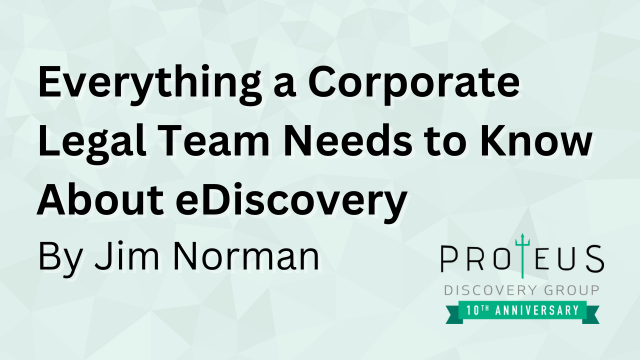
[EDRM Editor’s Note: EDRM is happy to amplify our Trusted Partners news and events.]
If your legal department handles complex litigation or regulatory matters, you already know that eDiscovery is more than a back-office function – it’s a critical business risk that touches data governance, compliance, IT, and outside counsel management.
And while your law firms and vendors may be in the weeds on specific workflows, the most costly and consequential decisions around discovery are often made inside your organization, whether explicitly or by default.
These breakdowns aren’t due to lack of intelligence or expertise – they’re the result of legal departments lacking a cohesive, repeatable playbook that connects internal priorities with external execution.
Jim Norman, Proteus Discovery Group.
Today’s most effective corporate legal teams are the ones that have stopped treating eDiscovery as a reactive vendor service and started managing it as a strategic business function – one with real impact on litigation outcomes, budgets, and institutional knowledge.
Where Most Corporate Teams Lose Control of eDiscovery
Even sophisticated legal departments fall into common traps that lead to unnecessary cost, inconsistent outcomes, and missed opportunities for improvement:
- Fragmented Workflows: Different internal stakeholders and business units engage external counsel with no centralized eDiscovery protocol, leading to redundant processes and unpredictable spend.
- Vendor-Led Strategy: Law firms defer to their preferred service providers, often without oversight from the corporate legal team. The result? A lack of pricing transparency, variable quality, and little continuity from one matter to the next.
- No Institutional Memory: Lessons learned, successful workflows, and cost-effective review models aren’t documented or carried forward—so the wheel gets reinvented every time.
- Delayed Engagement: Discovery isn’t considered until after outside counsel has been retained and deadlines are looming, which limits the ability to contain scope, assess risk, or shape workflows proactively.
These breakdowns aren’t due to lack of intelligence or expertise – they’re the result of legal departments lacking a cohesive, repeatable playbook that connects internal priorities with external execution.
Moving from Passive Oversight to Proactive Control
If your team is tasked with driving efficiency, predictability, and defensibility across legal matters, eDiscovery is one of the most high-leverage areas to focus on. It’s about trimming costs, and enabling better decisions and protecting your company’s broader interests.
Making that shift begins with standardizing the intake and scoping process across matters to minimize variability and better align expectations with outside counsel. Establishing centralized dashboards that monitor key metrics (like review rates, error rates, and cost per document) enables better forecasting and ongoing oversight. Leveraging Early Case Assessment (ECA) tools and applying strategic filtering at the front end of the process can drastically reduce data volumes and accelerate decision-making, which pays dividends in both budget control and responsiveness.
Establishing centralized dashboards that monitor key metrics (like review rates, error rates, and cost per document) enables better forecasting and ongoing oversight.
Jim Norman, Proteus Discovery Group.
Instead of relying on vendor-preferred tools that may not suit your matter, forward-looking legal departments are selecting partners who take a technology-agnostic approach—tailoring platforms and workflows to the needs of each case rather than forcing a square peg into a round hole. Finally, institutionalizing knowledge through well-documented playbooks ensures that every successful protocol, process, and insight becomes part of the legal department’s operating system, not just tribal knowledge that disappears with the next case closure.
These are tangible, scalable practices that drive value across litigation portfolios and strengthen the legal department’s position as a strategic business partner.
Why Now? Because the Cost of Inaction is Compounding
Data volumes continue to grow. Regulators are demanding faster, more transparent productions. Litigation deadlines aren’t getting looser.
If your internal processes can’t scale, if your outside counsel relationships don’t include clear discovery expectations, or if your team is being asked to do more with less, then your discovery approach needs to evolve.
That’s why we developed The Corporate Legal Team’s Playbook for eDiscovery—a concise, strategic guide for in-house legal leaders who want to regain control and reduce friction across matters.


